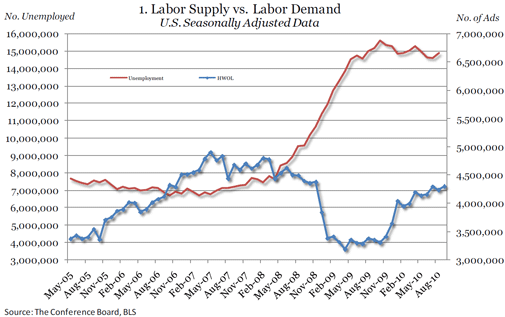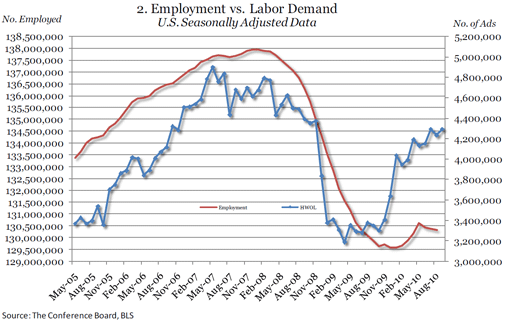- Online job demand increased by 1 million (30 percent) since the official end of the recession in June 2009
- September picture mixed across the U.S. with gains in Southern and Midwestern States, dips in labor demand in the Northeast and the West essentially flat
- September demand rose for workers in computer and mathematical science, transportation and material moving, and architecture and engineering while demand declined for sales and related workers and healthcare practitioners and technical jobs
“Since the NBER June 2009 end of the recession, HWOL has increased by 1 million advertised vacancies,” said June Shelp, Vice President at The Conference Board. “The HWOL series trough in April 2009 led the NBER official trough by about 2 months, reflecting a rather typical pattern where labor demand leads at economic turning points. Following the rapid HWOL rises in labor demand in the 4th quarter 2009 and 1st quarter 2010, labor demand has now settled into more modest growth, pointing to a moderate growth in employment through the end of 2010.”


REGIONAL AND STATE HIGHLIGHTS
- Moderate gains in Southern and Midwestern States partially offset by declines in Northeast and West
The South rose 25,400 in September, reflecting gains in three out of the six large States. Florida increased by 5,300 for a combined 4-month increase of 20,700. Florida is at its highest level since July 2008. North Carolina rose 5,900 in September while Georgia gained 4,000 and reached its highest level since April. Maryland dropped 2,400 in September to its lowest level since March. Virginia fell 1,700 to its lowest level since April. Texas experienced a small drop of 500. Among the less populous states in the South, advertised vacancies in Kentucky increased by 1,500, Louisiana increased by 600, and Oklahoma increased by 100.
The Midwest rose 11,800 in September after having risen 5,800 in August with several large states (Michigan, Ohio and Minnesota) in the region continuing to post gains. In September, Michigan rose 3,900 to 102,400, the highest level since the HWOL series began in May 2005. Ohio was up 4,100 in September and reached its highest level since November 2008. Missouri rose 3,900, and Minnesota rose 3,800 to its highest level since October 2008. Illinois declined a fairly sharp 7,700 in September after an August rise that had led to its highest level since June 2008. The September drop in Illinois largely reflected losses in Healthcare practitioners, Sales & related, and Management occupations. Wisconsin lost 800 this month after having decreased 500 in August. Among the States with smaller populations, Indiana gained 2,000 while North Dakota gained 800.
The Northeast region dipped 4,600 this month after an August decline of 19,200. Pennsylvania declined 6,300 in September largely due to a decline in the Healthcare practitioner occupations. Massachusetts gained 4,300 and reached its highest level since September 2008. New Jersey and New York both gained 700 in September. Among the smaller States, Connecticut declined 2,600. Maine and Rhode Island both dropped 1,000. Vermont and New Hampshire gained 500 and 300 respectively.
In the West labor demand was basically unchanged (-800). Washington declined by 3,500 to its lowest level since March 2010. California gained a modest 1,700 in September. Since January the number of advertised vacancies in California has hovered around 450,000 per month. Arizona gained 1,300 in September while Colorado inched up 400 and reached its highest level since November 2008. Among the smaller States, Nevada gained 1,100 and New Mexico gained a slim 100. Oregon, Alaska, and Hawaii dropped 900, 600, and 300 respectively.
The Supply/Demand rate for the U.S. in August (the latest month for which unemployment numbers are available) was at 3.51, indicating that there were more than 3 unemployed workers for every online advertised vacancy. Nationally, there are 10.6 million more unemployed workers than advertised vacancies. The number of advertised vacancies exceeded the number of unemployed in only North Dakota, where the Supply/Demand rate was 0.97. States with the next lowest rates include South Dakota (1.26), Alaska (1.33), and Nebraska (1.38), where the Supply/Demand rates reflected the fact that there was just over one unemployed for every online advertised vacancy. States with the highest Supply/Demand rates are Michigan (6.44) and Mississippi (6.30), where there are over 6 unemployed people for every advertised vacancy. Although still among the highest in the nation, Michigan’s S/D rate has improved significantly from the 10.2 in September 2009 when there were just over 10 unemployed for every online advertised vacancy. Other states with high S/D rates are Indiana (5.26) and California (4.98).
It should be noted that the Supply/Demand rate only provides a measure of relative tightness of the individual state labor markets and does not suggest that the occupations of the unemployed directly align with the occupations of the advertised vacancies (see Occupational Highlights section).
OCCUPATIONAL HIGHLIGHTS
- Demand for Computer and Mathematical Science workers rises 15,200 in September
- Demand for Sales and Related workers retreats 26,400 in September
- Demand for Healthcare Practitioners and Technical workers down for the third month in a row, but the number of advertised vacancies continues to exceed the unemployed by 2 to 1
vacancies, Computer and Mathematical Science occupations posted the largest September increase, up 15,200 to 587,900, offsetting the 14,000 loss in August. The increase was largely due to rising demand for computer software engineers (systems software) and web developers. Advertised vacancies in this field are at their highest level since September 2008. Demand for workers in this occupational category exceeds the number of unemployed looking for work by just over 3 to 1.
Transportation and Material Moving occupations posted the second largest September increase, up 9,900 to 147,700. The September rise was largely due to increases in demand for truck drivers and laborers and freight, stock, and material movers (hand). Advertised vacancies in this field are at their highest level since April 2007. The ratio between the number of unemployed looking for work and advertised vacancies was nearly 8 job-seekers for each advertised vacancy.
Demand for Architecture and Engineering occupations rose 9,200 to 179,000. The September increase was largely due to increases in demand for industrial engineers, electronics engineers except computer, electrical engineers, and aerospace engineers. Advertised vacancies in this field are at their highest level since November 2008. Advertised vacancies in this field outnumbered the unemployed looking for work in this field by 1.1 to 1.
Demand for Office and Administrative Support rose by 7,200 to 461,000 and was led by an increased demand for a wide variety of office staff positions including general office clerks, customer service representatives, shipping, receiving, and traffic clerks, and executive secretaries and administrative assistants. Advertised vacancies in this field are at their highest level since November 2008. However, there still remain almost four unemployed (3.9) looking for work in Office and Administrative Support for every advertised opening.
Sales and Related occupations fell 26,400 in September to 482,200. This month’s decline follows an upward trend in labor demand for sales workers that began in February 2009. The September decline was largely due to decreases in demand for first-line supervisors/managers of retail sales workers and sales representatives, wholesale and manufacturing, except technical and scientific products. The ratio between the number of unemployed looking for work and advertised vacancies was over 3 job-seekers for each advertised vacancy.
Labor demand for Healthcare Practitioners and Technical occupations dropped for the third month in a row and was down 26,200 in September to 516,300. The drop was largely due to decreases in advertised vacancies for registered nurses and physical and occupational therapists. Since January 2010 demand has dropped by a total of 51,100; however, the number of advertised vacancies continues to outnumber job seekers by over 2 to 1. Healthcare Support also dropped for the third straight month by 5,100 to 103,800, mainly due to the slide in physical and occupational therapist assistants. There were 2.8 unemployed for every advertised vacancy in healthcare support .
Healthcare is a broad field, and the relative tightness of the labor market varies substantially from the higher-paying practitioner and technical jobs to the lower-paying support occupations. In August, the latest month for which unemployment data are available, advertised vacancies for healthcare practitioners or technical occupations outnumbered the unemployed looking for work in this field by over 2 to 1, and the average wage in these occupations is $33.51/hour. In sharp contrast, the average wage for healthcare support occupations is $12.84/hour and there were nearly 3 unemployed looking for work in the field for every advertised vacancy.
Management occupations posted a September decrease of 11,500 to 577,300 and followed a gain of 8,300 in August. The September drop was largely due to decreases in demand for marketing managers, medical and health services managers, and sales managers. The ratio between the number of unemployed looking for work and advertised vacancies was slightly over one job seeker for each advertised vacancy.
Demand for Business and Financial Operations fell 9,500 to 222,200. The September decrease was largely due to decreases in demand for financial analysts, insurance adjusters, and training and development specialists. Like Management occupations, the ratio between the number of unemployed looking for work and advertised vacancies was slightly over one job seeker for each advertised vacancy.
Supply/Demand rates indicated that, among the occupations with the largest number of online advertised vacancies, there is a significant difference in the number of unemployed seeking positions in these occupations. Among the top ten occupations advertised online, there were more vacancies than unemployed people seeking positions for Computer and Mathematical Science (0.31), Healthcare Practitioners (0.41), and Architecture and Engineering (0.95). On the other hand, in Production occupations, there were nearly 11 people seeking jobs in this field for every online advertised vacancy (10.6) and there were nearly eight unemployed looking for work in Transportation and Material Moving positions for every advertised opening (7.8).
METRO AREA HIGHLIGHTS
- Washington, D.C., Oklahoma City, and Baltimore have the lowest Supply/Demand rates
- Online advertised vacancies in all of the 52 largest metropolitan areas are above last year’s levels
In September, all of the 52 metropolitan areas for which data are reported separately posted over-the-year increases in the number of online advertised vacancies. Among the three metro areas with the largest numbers of advertised vacancies, the New York metro area was 32 percent above its September 2009 level, the Washington, D.C. metro area was 14 percent above its September 2009 level, and the Los Angeles metro area was 26 percent above last year’s level.
The number of unemployed exceeded the number of advertised vacancies in all of the 52 metro areas for which information is reported separately. Washington, D.C., Oklahoma City, and Baltimore were the locations with the most favorable supply/demand rates, where the number of unemployed looking for work was only slightly larger than the number of advertised vacancies. On the other hand, metro areas in which the respective number of unemployed is substantially above the number of online advertised vacancies include Riverside, CA –where there are over 10 unemployed people for every advertised vacancy (10.2) – Detroit (7.3), Miami (5.7), and Sacramento (5.0). Supply/Demand rate data are for July 2010, the latest month for which unemployment data for local areas are available.





